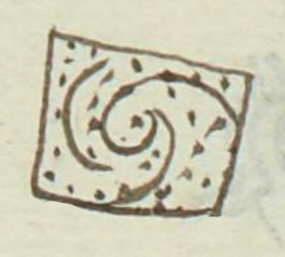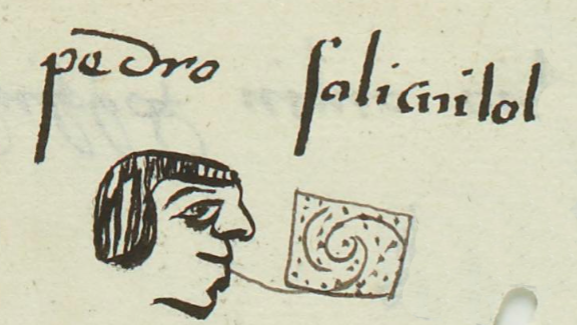Xalicuilol (MH603r)
This black-line drawing of the compound glyph for the personal name Xalicuilol (“Sand Painting,” attested here as a man’s name) shows a rectangular shape that could represent a painting (icuilolli). Inside the rectangle are dots that represent sand (xalli). The swirl may be there to suggest a pattern, a design, which icuilolli can also suggest.
Stephanie Wood
If this was not a sand painting (which is a phenomenon known in New Spain, in the part that is now the U.S. Southwest), then it may have been some kind of cultivation-intervention in a sandy parcel. The use of icuiloa in compounds relating to cuemitl (furrow) and tlalli (agricultural land parcel) can be found in a few glyphs shown below.
In the gloss, the starting letter (S) substitutes for the more standard X. This is somewhat unusual for Stage 1 orthography, but it does occur. See, for example, the gloss for Xolotl in the Matricula de Huexotzinco, folio 638 verso.
Marc Thouvenot identifies the verb icuiloa (or ihcuiloa, with the glottal stop), which means to paint, write, or print, as having a root of -cuil-. He notes how it also appears in tlacuiloliztli (writing), tlacuilo (writer), and cuicuiltic (mottled). He goes on to show various uses of icuiloa that take it beyond the simple definitions just given, resulting in something like the action of creating a design (e.g., on leather, ceramics, sculpture, or in textiles). It can also be something like the action of decorating (e.g., to put a flower on a cup of atole). He associates icuiloa and tlacuilolli with "cultural artifacts," such as arts and crafts or examples of writing and painting, but cuicuiltic with effects created by "nature." This short summary barely does his article justice; it is worth reading the entire piece. How Thouvenot's study might connect with the concept of bent or curved mentioned by Prem (1974: 555, 682) raises an interesting question. Perhaps the bent or curved lines of writing, painting, carving, embroidery, and so on, fall with in the realm of expressions of -cuil-. See
Marc Thouvenot, "Imágenes y escritura entre los nahuas del inicio del XVI," Estudios de Cultural Náhuatl 41 (2010).
Stephanie Wood
pedro salicuilol
Pedro Xalicuilol
Stephanie Wood
1560
Stephanie Wood
sand, arena, paintings, pinturas, cuadros, icuilol, writing, escritura

xal(li), sand, https://nahuatl.wired-humanities.org/content/xalli
icuilol(li), a piece of writing or a painting, https://nahuatl.wired-humanities.org/content/icuilolli
Pintura de Arena, o Diseño/Cultivo en la Arena
Stephanie Wood
Matrícula de Huexotzinco, folio 603r, World Digital Library, https://www.loc.gov/resource/gdcwdl.wdl_15282/?sp=287&st=image.
This manuscript is hosted by the Library of Congress and the World Digital Library; used here with the Creative Commons, “Attribution-NonCommercial-ShareAlike 3.0 License” (CC-BY-NC-SAq 3.0).













